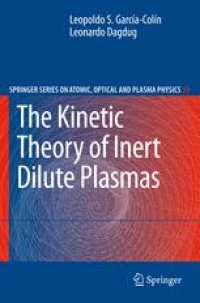
Ebook: The Kinetic Theory of a Dilute Ionized Plasma
- Tags: Atoms and Molecules in Strong Fields Plasma Physics, Thermodynamics, Astrophysics, Statistical Physics
- Series: Springer Series on Atomic Optical and Plasma Physics 53
- Year: 2009
- Publisher: Springer Netherlands
- Edition: 1
- Language: English
- pdf
This book results from recent studies aimed at answering questions raised by astrophycists who use values of transport coefficients that are old and often unsatisfactory. The few books dealing with the rigorous kinetic theory of a ionized plasma are based on the so called Landau (Fokker-Planck) equation and they seldom relate the microscopic results with their macroscopic counterpart provided by classical non-equilibrium thermodynamics. In this book both issues are thoroughly covered. Starting from the full Boltzmann equation for inert dilute plasmas and using the Hilbert-Chapman-Enskog method to solve the first two approximations in Knudsen´s parameter, we construct all the transport properties of the system within the framework of linear irreversible thermodynamics. This includes a systematic study of all possible cross effects (which, except for a few cases, were never treated in the literature) as well as the famous H-theorem. The equations of magneto-hydrodynamics for dilute plasmas, including the rather surprising results obtained for the viscomagnetic effects, may be now fully assessed. This book will be of immediate interest to the plasma physics community, as well as to astrophysicists. It is also likely to make an impact in the field of cold plasmas, involving laser cooled Rydberg atoms.
This book results from recent studies aimed at answering questions raised by astrophycists who use values of transport coefficients that are old and often unsatisfactory. The few books dealing with the rigorous kinetic theory of a ionized plasma are based on the so called Landau (Fokker-Planck) equation and they seldom relate the microscopic results with their macroscopic counterpart provided by classical non-equilibrium thermodynamics. In this book both issues are thoroughly covered. Starting from the full Boltzmann equation for inert dilute plasmas and using the Hilbert-Chapman-Enskog method to solve the first two approximations in Knudsen?s parameter, we construct all the transport properties of the system within the framework of linear irreversible thermodynamics. This includes a systematic study of all possible cross effects (which, except for a few cases, were never treated in the literature) as well as the famous H-theorem. The equations of magneto-hydrodynamics for dilute plasmas, including the rather surprising results obtained for the viscomagnetic effects, may be now fully assessed. This book will be of immediate interest to the plasma physics community, as well as to astrophysicists. It is also likely to make an impact in the field of cold plasmas, involving laser cooled Rydberg atoms.
This book results from recent studies aimed at answering questions raised by astrophycists who use values of transport coefficients that are old and often unsatisfactory. The few books dealing with the rigorous kinetic theory of a ionized plasma are based on the so called Landau (Fokker-Planck) equation and they seldom relate the microscopic results with their macroscopic counterpart provided by classical non-equilibrium thermodynamics. In this book both issues are thoroughly covered. Starting from the full Boltzmann equation for inert dilute plasmas and using the Hilbert-Chapman-Enskog method to solve the first two approximations in Knudsen?s parameter, we construct all the transport properties of the system within the framework of linear irreversible thermodynamics. This includes a systematic study of all possible cross effects (which, except for a few cases, were never treated in the literature) as well as the famous H-theorem. The equations of magneto-hydrodynamics for dilute plasmas, including the rather surprising results obtained for the viscomagnetic effects, may be now fully assessed. This book will be of immediate interest to the plasma physics community, as well as to astrophysicists. It is also likely to make an impact in the field of cold plasmas, involving laser cooled Rydberg atoms.
Content:
Front Matter....Pages i-x
Front Matter....Pages 3-3
Non-equilibrium Thermodynamics....Pages 5-11
The Problem....Pages 13-23
Solution of the Boltzmann Equation....Pages 25-39
Calculation of the Currents....Pages 41-49
Solution of the Integral Equations....Pages 51-59
The Transport Coefficients....Pages 61-71
Discussion of the Results....Pages 73-79
Front Matter....Pages 81-81
Viscomagnetism....Pages 83-105
Magnetohydrodynamics....Pages 107-123
Back Matter....Pages 125-166
This book results from recent studies aimed at answering questions raised by astrophycists who use values of transport coefficients that are old and often unsatisfactory. The few books dealing with the rigorous kinetic theory of a ionized plasma are based on the so called Landau (Fokker-Planck) equation and they seldom relate the microscopic results with their macroscopic counterpart provided by classical non-equilibrium thermodynamics. In this book both issues are thoroughly covered. Starting from the full Boltzmann equation for inert dilute plasmas and using the Hilbert-Chapman-Enskog method to solve the first two approximations in Knudsen?s parameter, we construct all the transport properties of the system within the framework of linear irreversible thermodynamics. This includes a systematic study of all possible cross effects (which, except for a few cases, were never treated in the literature) as well as the famous H-theorem. The equations of magneto-hydrodynamics for dilute plasmas, including the rather surprising results obtained for the viscomagnetic effects, may be now fully assessed. This book will be of immediate interest to the plasma physics community, as well as to astrophysicists. It is also likely to make an impact in the field of cold plasmas, involving laser cooled Rydberg atoms.
Content:
Front Matter....Pages i-x
Front Matter....Pages 3-3
Non-equilibrium Thermodynamics....Pages 5-11
The Problem....Pages 13-23
Solution of the Boltzmann Equation....Pages 25-39
Calculation of the Currents....Pages 41-49
Solution of the Integral Equations....Pages 51-59
The Transport Coefficients....Pages 61-71
Discussion of the Results....Pages 73-79
Front Matter....Pages 81-81
Viscomagnetism....Pages 83-105
Magnetohydrodynamics....Pages 107-123
Back Matter....Pages 125-166
....